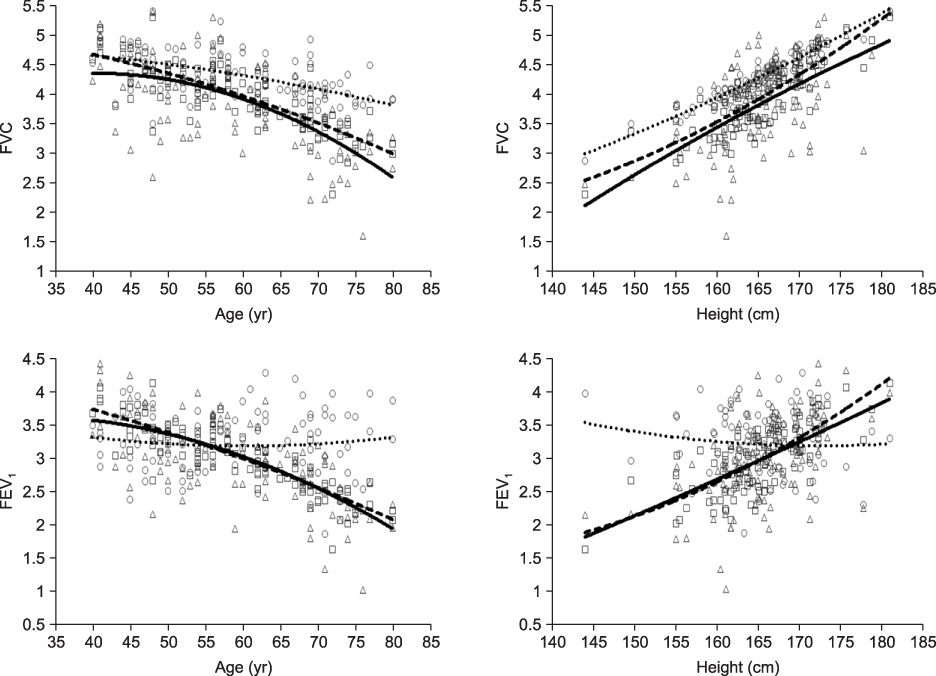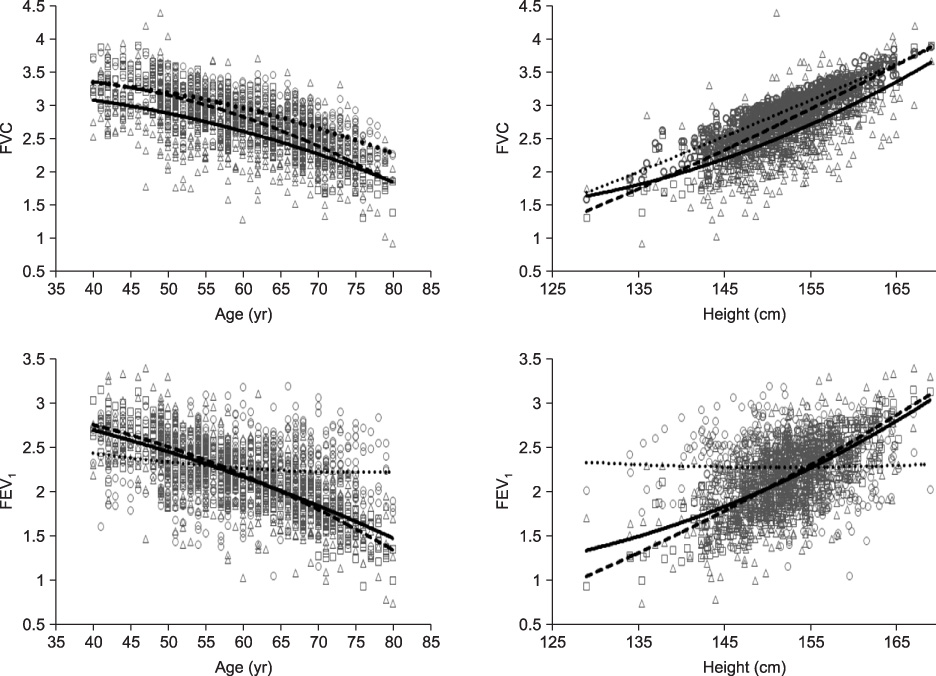Tuberc Respir Dis.
2012 Mar;72(3):302-309.
Goodness-of-Fits of the Spirometric Reference Values for Koreans and USA Caucasians to Spirometry Data from Residents of a Region within Chungbuk Province
- Affiliations
-
- 1Department of Preventive Medicine and Medical Research Institute, Chungbuk National University College of Medicine, Cheongju, Korea. kimheon@chungbuk.ac.kr
- 2Asbestos Damage Relief Center, Korea Environment Coporation, Incheon, Korea.
- 3Environmental Health Research Division, Environmental Health Research Department, National Institute of Environmental Research, Incheon, Korea.
- 4Department of Internal Medicine, Medical Research Institute, Chungbuk National University College of Medicine, Cheongju, Korea.
- 5Department of Radiology, Medical Research Institute, Chungbuk National University College of Medicine, Cheongju, Korea.
- 6Department of Preventive Medicine, Chung-Ang University College of Medicine, Seoul, Korea.
- 7Department of Preventive Medicine, Konkuk University College of Medicine, Chungju, Korea.
Abstract
- BACKGROUND
Korean regression models for spirometric reference values are different from those of Americans. Using spirometry results of Korean adults, goodness-of-fits of the Korean and the USA Caucasian regression models for forced vital capacity (FVC) and forced expiratory volume in one second (FEV1) were compared.
METHODS
The number of study participants was 2,360 (1,124 males and 1,236 females). Spirometry was performed under the guidelines of the American Thoracic Society and the European Respiratory Society. After excluding unsuitable participants, spirometric data for 729 individuals (105 males and 624 females) was included in the statistical analysis. The estimated FVC and FEV1 values were compared with those measured. Goodness-of-fits for Korean and USA Caucasian models were compared using an F-test.
RESULTS
In males, the expected values of FVC and FEV1 using the Korean model were 12.5% and 5.7% greater than those measured, respectively. The corresponding values for the USA Caucasian model were 3.5% and 0.6%. In females, the difference in FVC and FEV1 were 13.5% and 7.7% for the Korean model, and 6.3% and 0.4% for the USA model, respectively. Goodness-of-fit for the Korean model regarding FVC was not good to the study population, but the Korean regression model for FEV1, and the USA Caucasian models for FVC and FEV1 showed good fits to the measured data.
CONCLUSION
These results suggest that the USA Caucasian model correlates better to the measured data than the Korean model. Using reference values derived from the Korean model can lead to an overestimation regarding the prevalence of abnormal lung function.
MeSH Terms
Figure
Reference
-
1. Miller MR, Hankinson J, Brusasco V, Burgos F, Casaburi R, Coates A, et al. Standardisation of spirometry. Eur Respir J. 2005. 26:319–338.2. Hankinson JL, Odencrantz JR, Fedan KB. Spirometric reference values from a sample of the general U.S. population. Am J Respir Crit Care Med. 1999. 159:179–187.3. Kim WY, Kim KH, Youn BH, Lee SU, Cho CH, Choi JS, et al. Prediction equations of pulmonary function parameters derived from the forced expiratory spirogram for healthy adults over 50 years old in rural area. Tuberc Respir Dis. 1998. 45:536–545.4. Choi JK, Paek D, Lee JO. Normal predictive values of spirometry in Korean population. Tuberc Respir Dis. 2005. 58:230–242.5. Oh YM, Hong SB, Shim TS, Lim CM, Koh Y, Kim WS, et al. Effect of a new spirometric reference equation on the interpretation of spirometric patterns and disease severity. Tuberc Respir Dis. 2006. 60:215–220.
- Full Text Links
- Actions
-
Cited
- CITED
-
- Close
- Share
- Similar articles
-
- Reference Values for the Pulmonary Function of Korean Adults Using the Data of Korea National Health and Nutrition Examination Survey IV (2007-2009)
- Spirometric Standards for Healthy Children and Adolescents of Korean Chinese in Northeast China
- Reference Values for Spirometry Derived Using Lambda, Mu, Sigma (LMS) Method in Korean Adults: in Comparison with Previous References
- The effect of applying ethnicity-specific spirometric reference equations to Asian migrant workers in Korea
- Effect of a New Spirometric Reference Equation on the Interpretation of Spirometric Patterns and Disease Severity




